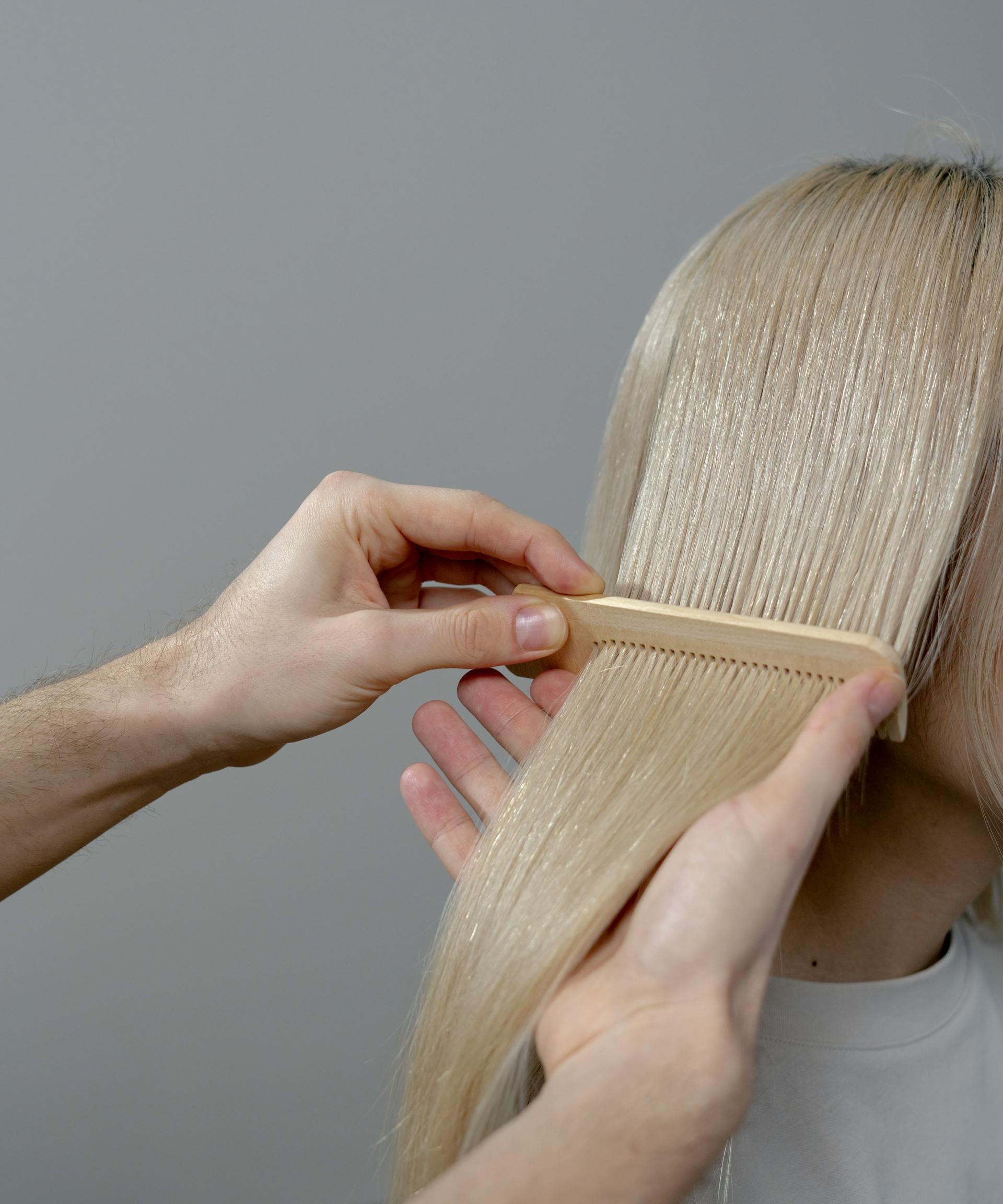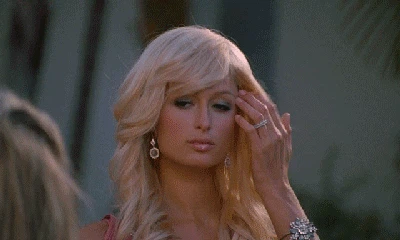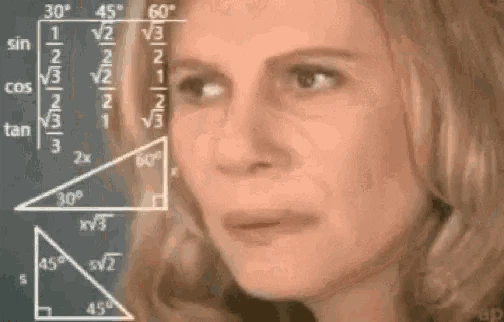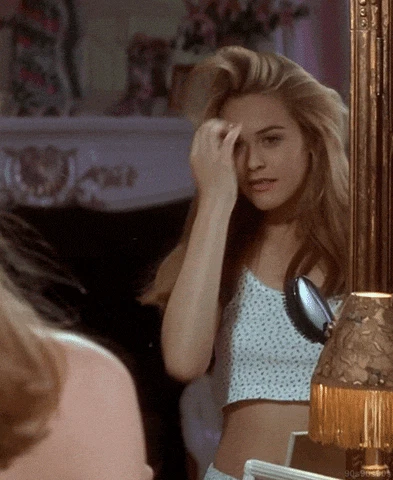Do Blondes Really Have More Fun? I Bleached My Hair And Found Out
Trends come and go more quickly than we can even keep up with, but one thing is for certain – blonde is eternal.

Ever since I was old enough to rebel against my parents by collecting quarters (yes, quarters!) and buying cheap, at-home boxed hair dye, I've been experimenting with almost every hair color under the sun. In my edgiest, Tumblrina days, you would’ve come across an Andrea rocking a bright green pixie cut followed by rich orange or deep purple. My hair has even been cherry red belly-button length with bangs and a pitch-black bob.
Sure, I’ve mellowed out over the years and respect myself a little bit more to get quality work done in a salon instead of haphazardly scrubbing chemicals on my head, but regularly switching haircuts and colors is still pretty on-brand for me. But what had I never tried, yet always dreamed of? Blonde.
Part of me didn’t think I could pull it off, and part of me felt like it would be more hassle than it was worth. I mean, I had bleached my hair back in the “crayon box” hair color days, but my hair was short enough not to show bleaching damage, and I was laying colors on top, so proper lightening protocol was never really part of my process. That is, until last month.
I finally allowed myself to scratch that itch and go from basically black hair to blonde, and guess what? I think I’m sold on the idea that blondes really do have more fun. Here's why.
Evie's product selections are curated by the editorial team. If you buy something through our links, we may earn an affiliate commission, at no cost to you. We only recommend products we genuinely love.
What Does Being Blonde Actually Mean?
Every single hair color conveys symbolic meanings and comes with its own set of stereotypes, whether we personally agree with them or not. Some say that gingers are short-tempered or have “no soul,” others believe that brunettes are bookworms, and many perpetuate the perception that blondes are dumb. Longitudinal surveys have since squashed that claim, finding that in terms of IQ, blondes aren’t less smart than those with brown, black, or red hair.
Nevertheless, the “dumb blonde” generalization likely stemmed from the trope of the “bimbo,” a hot but vacuous woman. Though the term “bimbo” was initially meant in a derogatory sense, today, people take it more in jest, and some are even trying to reclaim the aesthetic with a warm embrace.
Bottle blondes, bleach blondes, Barbie blondes, or blonde bimbos are stereotyped as bubbly and fun but also shallow and objectifiable, relying on their looks over intelligence.
This concept was likely popularized thanks to characters like Jean Harlow’s Lola Burns in the 1933 film Bombshell or Marilyn Monroe’s Lorelei Lee in the 1953 film Gentlemen Prefer Blondes, but it continued to be drilled into the cultural zeitgeist by other movies like Clueless, Mean Girls, The House Bunny, or blonde celebrities with ditzy personas like Paris Hilton. Y2K’s maximalist aesthetics, saturated with bottle blondes wearing hyperfeminine shades of pink and blue, certainly didn’t help the case for blonde, but it was wistfully iconic.

Hollywood has, of course, tried to cinematically challenge unfavorable blonde stereotypes in films like Legally Blonde or Atomic Blonde, but no matter – we’ve heard it time and time again that blondes are more adventurous (in the bedroom and beyond), bubbly, extroverted, energetic, and spontaneous. All of these characteristics lead people to repeat the age-old adage that “blondes have more fun.”
Let’s See What “The Science” Has To Say
Way back in 2003 – a.k.a. peak Y2K bimbo-fied blonde era – e-dating platform Match released data from their dating metrics reporting that blondes on the website got more attention, on average, from male suitors than redheads and brunettes. Match additionally reported at the time that their lighter-haired users were actually more likely to have obtained college and graduate degrees.
These findings have been supported over the years through other research, which found that blonde women earn more money whether in salaried work or simply waitressing. Yes, blondeness could positively affect wages to the extent that the premium is “similar in size to the return from an extra year of schooling.” What will it be, a whole year of courses and studying, or a couple 8-hour sessions in the salon chair getting each strand of your hair chemically lightened?

To determine if blondes have “more fun,” you really have to work through several steps of pseudoscientific logic. If a woman makes more money, then perhaps she is more often in a better mood because she’s less stressed about her financial status and can afford to take trips, pamper herself, enjoy a night out, and automate many icky responsibilities that might make a less financially stable woman seem serious, morose, or outright dour.
Similarly, if a woman feels more desirable and receives more accolades or attention from colleagues, friends, or potential suitors, this could be a big boost to her self-confidence. But all that said, there’s no way to prove that any of those things always guarantee “more fun.”
More recent research published in The Journal of Social Psychology suggested that women with lighter hair are perceived to be youthful, healthy, and attractive. The same study found that blondeness also indicated a woman as better marriage and mother material. All research comes with caveats, however, and most survey participants were white male college students who have undeniably been shaped by the women that the media prop up on pedestals as the pinnacle of beauty.
Throughout the aughts and into the 2020s, actresses like Scarlett Johansson, Rachel McAdams, Blake Lively, Margot Robbie, and now Sydney Sweeney have served as one leading standard for feminine beauty. Models like Gisele Bündchen, Candice Swanepoel, Cara Delevingne, Karlie Kloss, or Gigi Hadid also fit this blonde bill.
While there are certainly many objectively hot female celebrities in modern times that rock brunette, red, or black tresses (hello Miranda Kerr, EmRata, and Gal Gadot!), it's pretty clear that Hollywood has had a preference toward gals with glistening, golden hair.
This has to be kept in mind when looking at all the other research out there, which is inherently influenced by cultural norms rather than just human nature alone. In one 2011 experiment, researchers tried to see if a blonde woman nightclubbing in London was approached more often than when she wore her hair brown or red. This concept was tested by other researchers the following year. Both experiments concluded that blonde women were approached more than the others.
What’s more, blondes may even receive help more often than brunettes or redheads. One French study found that male pedestrians are more likely to alert a blonde woman that she dropped a glove than women with other hair colors. The researchers, again, believe that this could be explained by the notion that men associate blondeness with health, youth – and consequently – fertility. There is, of course, a common social construct that associates “light” traits with “being attractive and ‘good.’”
So, is this all evolutionary or learned? Apparently, even the father of evolutionary theory, Charles Darwin, tried to figure out if hair color does indeed affect a woman’s ability to find a man. His results were, unsurprisingly, inconclusive because it’s not possible for a physical trait to pre-empt human behavior.
The very act of being blonde by birth or having blonde hair as a result of lightening it doesn’t indicate anything about a person’s distinctive personality. Your personality and, as a result, your likeability among potential mates is shaped by more than just cultural heritage or willingness to lighten your hair – you’re a unique human being whose behavior is significantly affected by your family, location, education, health, socioeconomic status, and so much more.
Blondeness Is a Commitment, But I’ve Gleefully Pledged My Allegiance
Now, do I feel as though I’ve changed since going blonde? My personal answer is a bit complicated. Upon trying to get to the bottom of the question “do blondes really have more fun,” I came across a study by Goody which found that blondes spend on average six minutes more getting ready than women with darker hair and that three-quarters of blondes stick to their daily beauty regimen.
For an unnatural blonde, I’d have to say that findings like that certainly reflect my own personal experience. I’m someone who has prided herself on having locked in a really quick but effective makeup routine. Navigating bleached blondeness is a whole new can of worms I recently opened.
For instance, am I using hair masks and oil regularly and sufficiently enough to repair damaged bonds and coat my strands so they look hydrated, not thirsty and frazzled? Is my hair starting to look a little brassy and needs some toning? Do I have split ends from the bleaching, which need a quick dusting at home?
I have to be a lot more deliberate with hair care and upkeep. Thankfully, I’ve invested in several products to survive this initial period of extremely damaged hair, but I have yet to master the process. As time goes on, I’m sure I’ll find new holy grail products, but for now, I’ve been a slave to my Amika “Bust Your Brass” Intense Repair Hair Mask because it strengthens and hydrates my hair while also toning with a reasonable dose of purple pigment.
Additionally, I’ve tried not to go totally overboard on Olaplex No. 7 Bonding Oil because a little bit of it goes a long way, but it has been such a game-changer for visibly improving my hair’s softness and shine. This oil is supposed to build bonds and repair breakage (to the extent that you can, I mean… hair is dead anyway, and all dye negatively affects these dead strands), so I’m trusting the process – especially since I regularly apply heat to my hair to blow dry and style it.
This product actually came as a recommendation to me almost a year ago by fellow Evie writer Hannah Leah and hair stylist, who recommended that I mix it with Olaplex No. 6 Bond Smoother prior to using heat on my hair.
I must reiterate that I took my hair from basically black to bright, bright blonde. Let that sink in for a little bit to really understand just how much damage I willingly inflicted on my hair.
So, now that I’ve bleached my hair near platinum, I’m glad I had stocked up on those salon-quality products rather than try to pinch pennies and go for budget picks. After all, I didn’t spend hours of my time and many dollars out of my bank account for nothing! Blonde is an investment, and I’m in it for the long haul to properly maintain my mane.
Alright, But Do Blondes Actually Have More Fun?
But is this time-consuming maintenance additive to the overall “fun” I experience in life now that I’m blonde, or does it actually make life a little harder? Honestly, I can’t say it’s easy dealing with bleached hair, but the pros outweigh all the cons for me.
First off, natural blondeness is pretty rare, and most children who have blonde hair growing up may not end up with blonde hair later on in life due to the melanin in genes darkening the hair as time goes on. While growing up as the only brunette surrounded by three blondes whom I looked up to (a.k.a. my mom and two older sisters), I always yearned to look a little bit more like them.
Second, I could only scratch so much of that appearance-altering itch without resorting to drastic measures. You know when you’re just antsy to make some sort of change “just to feel something”? Haircuts and coloring were always my go-to, but after cutting my hair to shoulder length last year with bangs, I wasn’t eager to do a drastic chop again.

Third, reinventing your look is a bonafide way to have fun. If you know, you know. It can be as simple as wearing a new, coordinated outfit or walking out of the salon with a completely fresh ‘do. Sure, some people joke that women make physical changes to our appearances after breakups or an important event in our lives, but changing your appearance isn’t just an act of defiance toward routine – it’s a strategic boost to your self-confidence.
Life is short, so why not creatively experiment in a healthy manner? A new hair color can be a way to rebrand your identity as you grow and evolve. Plus, when you look your best, you tend to feel your best as well. Altering your physical appearance certainly isn’t a solution for any actual issues you may be having, but it’s a quick way to boost some serotonin and allow yourself to enjoy all of life’s offerings.
Finally, I’m really grateful I bleached the living daylights out of my hair because I have now actually forced myself into new levels of self-care. When I was sticking to darker shades more similar to my natural color, I didn’t really bother to do much beyond my regular wash and dry routine. As a blonde, I’m trying to learn more about hair masks, hair oils, protective treatments – you name it. I’ve had to slow down, rethink my routines, and be patient with a new process.
Closing Thoughts
I know I’m not alone when I say that taking the time to outright refresh or even properly maintain your appearance is worth it. Little bits of superficial self-care here and there are fun, but actually investing in your physical beauty is a great way to improve your self-confidence and, as a result, be a more fun person to be around.
You certainly don’t need to go full-Barbz like I did – making the potentially dangerous move from deep, dark brown to light blonde within a month – but if you’re even considering making any change, I’d encourage you to literally and metaphorically let your hair down and at least try.
Support our cause and help women reclaim their femininity by subscribing today.